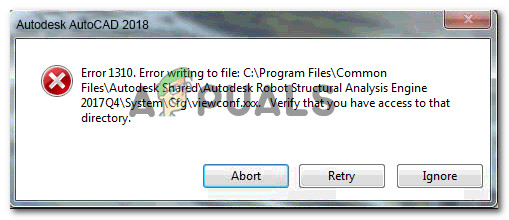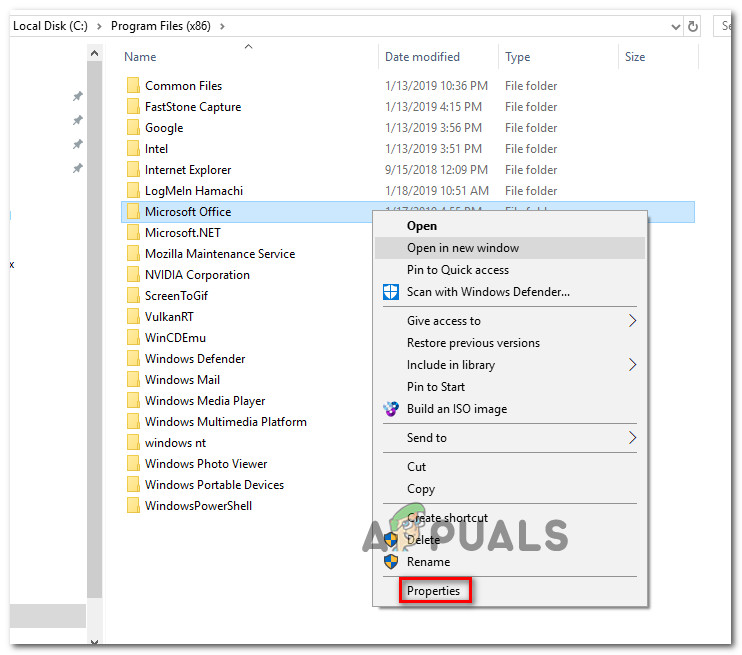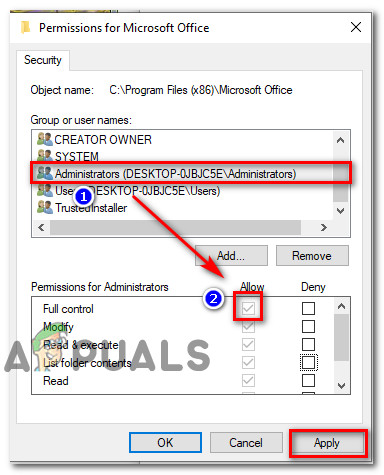Fix: Error 1310 Error Writing to File
Several users have reported that they encounter the “Error 1310 Error writing to file” message when trying to install a program on a Windows computer. The error is typically reported to occur in the initial stages of the installation. The error is mostly reported to occur when installing standalone programs from the Microsoft suite (Excel, Word, Powerpoint.etc.), Adobe programs (Illustrator, Photoshop) and AutoDesk programs (Inventor, AutoCAD) but there are other lesser known software products that will trigger the same error message. The error 1310 error writing to file is confirmed to occur on Windows 7, Windows 8 and Windows 10.

What is causing the ‘error 1310 error writing to file’ issue?
We investigated this particular issue by looking at the various user reports and the repair strategies that affected users deployed to resolve the issue. Based on our findings, there are several common culprits that are known to trigger this particular error:
- The computer contains file remnants from older application version – This particular error is quite common in those instances where the user previously had a similar version of the same application and did not uninstall it properly. In this case, the solution is to take care of the remnant file manually or use the uninstall feature
- The user does not have sufficient privileges to install the software in that folder – This issue is typically reported to occur with Microsoft Office, Adobe and AutoCAD software products. In this particular case, the issue can be resolved by granting the appropriate permissions to the folder indicated by the error message.
- The Windows Installer is glitched – There are quite a few occurrences where the Windows Installer (Msiexec.exe) was confirmed to be responsible for this particular error message. A lot of users encountering this issue have managed to resolve it by unregistering & re-registering the Msiexec.exe file (Method 2).
If you’re struggling to resolve this particular error message, this article will provide you with several verified troubleshooting steps. Down below, you’ll discover a selection of potential fixes that other users in a similar situation have used to get the issue resolved.
For the best results, follow the methods below in the order that they are presented until you encounter a fix that allows you to resolve or circumvent the issue in your particular scenario.
Let’s begin!
Method 1: Ensuring that you don’t have multiple versions of the same program
With several programs (the Microsoft suite in particular) the issue will sometimes occur because the computer you’re trying to install the software on already has a version of the same software installed. Before you try any other fix, it’s important to ensure that the software you’re trying to install is not already present (in a different version) on this particular computer.
It’s also possible that you have remnant files from an older installation of the same program, which prevents the installer to copy the file in that folder.
Several users that have been struggling to resolve the issue for themselves have reported that they were able to resolve the issue by accessing the Programs and Files menu and uninstalling every version (older or newer) of the same software.
Note: This method was confirmed to be successful by a lot of users that we’re encountering the issue with Microsoft Office. We also identified a couple occurrences with users who were trying to install Photoshop CC when they already had install Photoshop CS4 or CS5.
Note 2: If you are encountering this issue with Microsoft Office, you can use the appropriate FixIt to ensure that any remnant files from an old Microsoft Office installations are removed. You can download the FIxIt from (here).
- Press Windows key + R to open up a Run dialog box. Then, type appwiz.cpl and press Enter to open up Programs and Files.

Type appwiz.cpl and Press Enter to Open Installed Programs List - Inside Programs and Features, right-click on each version of the same program that you’re trying to install and click Uninstall.

Uninstalling other versions from the same software - Follow the on-screen prompts to complete the uninstallation, then restart your computer.
- At the next startup, install the software package that was previously triggering the “Error 1310 Error writing to file” and see if the issue has been resolved.
If you’re still encountering the same error message, move down to the next method below.
Method 2: Unregistering & re-registering the Windows Installer (Msiexec.exe)
Most applications that you’ll ever attempt to install on your Windows computer will use the Windows Installer technology (which in turn uses Msiexec.exe) to install MSI and MSP packages. Several users that we’re encountering the error 1310 error writing to file when trying to install the Microsoft Office suite have reported that the issue was no longer occurring once they unregistered > registered Msiexec.
Keep in mind that this step is easier than you might think. Here’s what you need to do:
- Press Windows key + R to open up a Run dialog box. Then, type “msiexec /unregister” and press Enter to unregister the process.
- Press Window key + R to open up another Run dialog box. This time, type “msiexec /regserver” and press Enter to re-register the process.
- Restart your computer and attempt to reinstall the software at the next startup to see if the issue has been resolved.

If you’re still encountering the issue, move down to the next method below.
Method 3: Granting yourself Full Control to the Installation folder
Another fix that was successful for a lot of users is to ensure that you have the necessary permissions to write the required data into the installation folder. We found this method to be effective in a lot of situations where the user tried to installed AutoDesk product (Inventor, AutoCAD, etc).
As you probably noticed, the error message points towards a particular folder and suggests that you should verify whether you have access to that particular directory. Well, that’s exactly what we’re going to do.
A lot of affected users have reported that the issue has been resolved after they granted Full Control to the Administrators and Users group in the Properties screen of the folder. Here’s what you need to do:
- Use File Explorer to navigate to the location of the Folder responsible for the error. For example, let’s say that we’re trying to install Microsoft Word and the error points towards the Microsoft Office folder. In this case, we’ll navigate to C:\Program Files (x86), right-click on Microsoft Office and choose Properties.

Opening the Properties menu of the folder responsible for the error Note: If you are unable to find the folder signaled by the error message, chances are it’s hidden by default. In this case, open a Run box (Windows key + R) and type “control folders“. Then, go over to the View tab, go to the Advanced settings and set the toggle associated with Hidden files and folders to Show hidden files, folders and drives. Then, hit Apply to save the changes.
- Inside the Properties menu of the folder, go to the Security tab and click Edit… to change permissions.

Accessing the permission menu of the folder - In the newly appeared dialog box, select the Administrators Group (under Group or user names) and then ensure that the Full Control box is checked (under Permissions for Administrators). Then, select the Users group and grant them Full Control (just as you did with the Administrators group) and hit Apply to save the changes.

Modifying the permissions Note: If the application extends on multiple folders, repeat the process above with each location.
- Restart your computer and see if the issue has been resolved.




